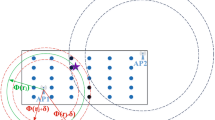Abstract
In the WiFi-based indoor positioning system (IPS), by using WiFi access points (APs) on hand and without requiring the APs’ positions, the scene analysis method has better positioning accuracy and attracts many researchers to devote their efforts to it. However, this method needs to perform a sampling process in order to collect the received signal strength indicators (RSSIs) of the APs from the places of interest to build the building’s WiFi radio fingerprint database in advance. It also needs to resample frequently in order to keep the fingerprint database updated and accurate. Both tasks are time-consuming, therefore we propose a quick radio fingerprint collection (QRFC) algorithm for collecting the sampling information. The Android smartphone and its built-in motion sensors were used to help the collection process. QRFC makes the sampling process simpler, and the time needed for the sampling is close to the time of walking slowly through the path. We also propose a heuristic AP RSSI shaping algorithm to compensate for the signal attenuation caused by multi-path, shadowing, and mask effects. Several field tests were performed to compare the QRFC method to the traditional method. Experiments show that there is no significant difference in their accuracy, but QRFC takes much less time to complete.














Similar content being viewed by others
References
Yang C, Shao HR (2015) WiFi-based indoor positioning. IEEE Commun Mag 53(3):150–157
Zhuang Y, Syed Z, Li Y, Ei-Sheimy N (2015) Evaluation of two WiFi positining systems based on autonomous crowdsourcing of handheld devices for indoor navigation. IEEE Trans Mob Comput. doi:10.1109/TMC.2015.2451641
Sayed AH, Tarighat A, Khajehnouri N (2005) Network-based wireless location: challenges faced in developing techniques for accurate wireless location information. IEEE Signal Process Mag 22(4):24–40
Liu HH, Lo WH, Tseng CC, Shin HY (2014) A WiFi-based weighted screening method for indoor positioning systems. Wirel Pers Commun 79(1):611–627
Gwon Y, Jain R (2004) Error characteristics and calibration-free techniques for wireless LAN-based location estimation. Proc of ACM MobiWac’04 2–9
Bahl P, Padmanabhan VN (2000) RADAR: an in-building RF-based user location and tracking system. Proc IEEE INFOCOM 775–784
Liu H, Darabi H, Banerjee P, Liu J (2007) Survey of wireless indoor positioning techniques and systems. IEEE TSMCC 6(6):1067–1080
Naguib A, Pakzad P, Palanki R, Poduri S, Chen Y (2013) scalable and accurate indoor positioning on mobile devices. International Conference on Indoor Positioning and Indoor Navigation, Montbeliard-Belfort, France
Constandache I, Choudhury RR, Rhee I (2010) Towards mobile phone localization without war-driving. Proc IEEE INFOCOM 1–9
Luo J, Zhan X (2014) Characterization of smart phone received signal strength indication for WLAN indoor positioning accuracy improvement. J Netw 9(3):739–746
Qian J, Ma J, Ying R, Liu P, Pei L (2013) An improved indoor localization method using smartphone inertial sensors. International Conference on Indoor Positioning and Indoor Navigation, Montbeliard-Belfort, France
Libby R (2008) A simple method for reliable footstep detection in embedded sensor platforms. [Online] Available: http://ubicomp.cs.washington.edu/uwar/libby_peak_detection.pdf
Liu HH, Yang YN (2011) WiFi-based indoor positioning for multi-floor environment. Proc IEEE TENCON, Bali, Indonesia 597–601
Acknowledgments
This work was supported by Ministry of Sci. and Tech. of Taiwan, R.O.C. under Grants MOST 103-2221-E-033 -045.
Author information
Authors and Affiliations
Corresponding author
Rights and permissions
About this article
Cite this article
Liu, HH. The Quick Radio Fingerprint Collection Method for a WiFi-Based Indoor Positioning System. Mobile Netw Appl 22, 61–71 (2017). https://doi.org/10.1007/s11036-015-0666-4
Published:
Issue Date:
DOI: https://doi.org/10.1007/s11036-015-0666-4




